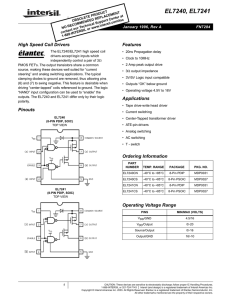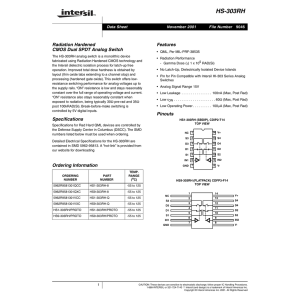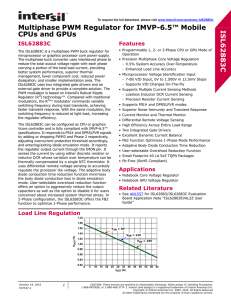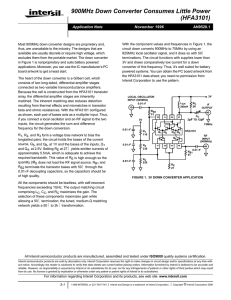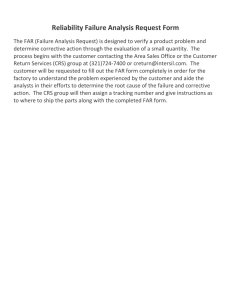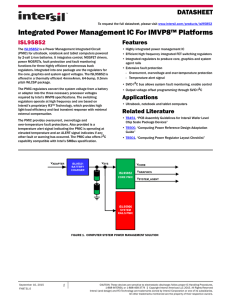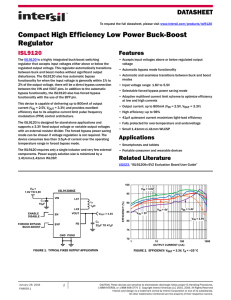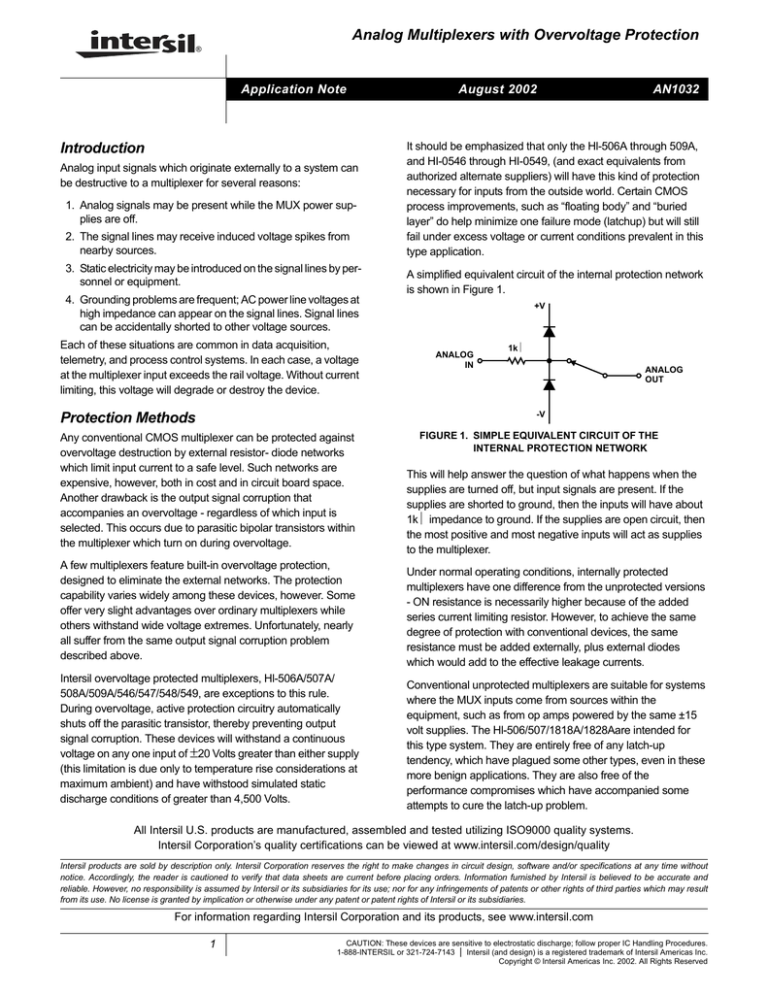
Analog Multiplexers with Overvoltage Protection
®
Application Note
Introduction
Analog input signals which originate externally to a system can
be destructive to a multiplexer for several reasons:
1. Analog signals may be present while the MUX power supplies are off.
2. The signal lines may receive induced voltage spikes from
nearby sources.
3. Static electricity may be introduced on the signal lines by personnel or equipment.
4. Grounding problems are frequent; AC power line voltages at
high impedance can appear on the signal lines. Signal lines
can be accidentally shorted to other voltage sources.
Each of these situations are common in data acquisition,
telemetry, and process control systems. In each case, a voltage
at the multiplexer input exceeds the rail voltage. Without current
limiting, this voltage will degrade or destroy the device.
Protection Methods
August 2002
AN1032
It should be emphasized that only the Hl-506A through 509A,
and HI-0546 through HI-0549, (and exact equivalents from
authorized alternate suppliers) will have this kind of protection
necessary for inputs from the outside world. Certain CMOS
process improvements, such as “floating body” and “buried
layer” do help minimize one failure mode (latchup) but will still
fail under excess voltage or current conditions prevalent in this
type application.
A simplified equivalent circuit of the internal protection network
is shown in Figure 1.
+V
ANALOG
IN
1kΩ
ANALOG
OUT
-V
Any conventional CMOS multiplexer can be protected against
overvoltage destruction by external resistor- diode networks
which limit input current to a safe level. Such networks are
expensive, however, both in cost and in circuit board space.
Another drawback is the output signal corruption that
accompanies an overvoltage - regardless of which input is
selected. This occurs due to parasitic bipolar transistors within
the multiplexer which turn on during overvoltage.
A few multiplexers feature built-in overvoltage protection,
designed to eliminate the external networks. The protection
capability varies widely among these devices, however. Some
offer very slight advantages over ordinary multiplexers while
others withstand wide voltage extremes. Unfortunately, nearly
all suffer from the same output signal corruption problem
described above.
Intersil overvoltage protected multiplexers, Hl-506A/507A/
508A/509A/546/547/548/549, are exceptions to this rule.
During overvoltage, active protection circuitry automatically
shuts off the parasitic transistor, thereby preventing output
signal corruption. These devices will withstand a continuous
voltage on any one input of ±20 Volts greater than either supply
(this limitation is due only to temperature rise considerations at
maximum ambient) and have withstood simulated static
discharge conditions of greater than 4,500 Volts.
FIGURE 1. SIMPLE EQUIVALENT CIRCUIT OF THE
INTERNAL PROTECTION NETWORK
This will help answer the question of what happens when the
supplies are turned off, but input signals are present. If the
supplies are shorted to ground, then the inputs will have about
1kΩ impedance to ground. If the supplies are open circuit, then
the most positive and most negative inputs will act as supplies
to the multiplexer.
Under normal operating conditions, internally protected
multiplexers have one difference from the unprotected versions
- ON resistance is necessarily higher because of the added
series current limiting resistor. However, to achieve the same
degree of protection with conventional devices, the same
resistance must be added externally, plus external diodes
which would add to the effective leakage currents.
Conventional unprotected multiplexers are suitable for systems
where the MUX inputs come from sources within the
equipment, such as from op amps powered by the same ±15
volt supplies. The Hl-506/507/1818A/1828Aare intended for
this type system. They are entirely free of any latch-up
tendency, which have plagued some other types, even in these
more benign applications. They are also free of the
performance compromises which have accompanied some
attempts to cure the latch-up problem.
All Intersil U.S. products are manufactured, assembled and tested utilizing ISO9000 quality systems.
Intersil Corporation’s quality certifications can be viewed at www.intersil.com/design/quality
Intersil products are sold by description only. Intersil Corporation reserves the right to make changes in circuit design, software and/or specifications at any time without
notice. Accordingly, the reader is cautioned to verify that data sheets are current before placing orders. Information furnished by Intersil is believed to be accurate and
reliable. However, no responsibility is assumed by Intersil or its subsidiaries for its use; nor for any infringements of patents or other rights of third parties which may result
from its use. No license is granted by implication or otherwise under any patent or patent rights of Intersil or its subsidiaries.
For information regarding Intersil Corporation and its products, see www.intersil.com
1
CAUTION: These devices are sensitive to electrostatic discharge; follow proper IC Handling Procedures.
1-888-INTERSIL or 321-724-7143 | Intersil (and design) is a registered trademark of Intersil Americas Inc.
Copyright © Intersil Americas Inc. 2002. All Rights Reserved

